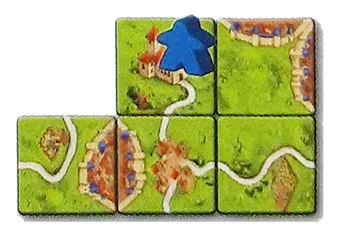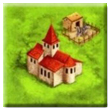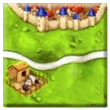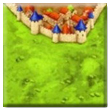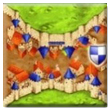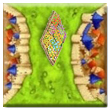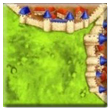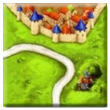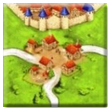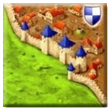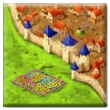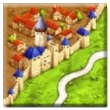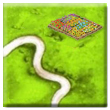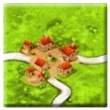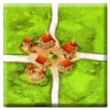Demo Spiel
 |
You are reading the rules for this tile design. |
| If your tiles have a different design, then choose a game from Spin-offs. |  |
General info and comments
Promotional mini game version of Carcassonne contained in the 999 Games 25th anniversary box in 2015. Also released by Hans im Glück in a German edition.
The game is for two players and contains 20 smaller tiles and 8 smaller meeples in two colors. All base game rules apply, except farmers. A summary of the rules is printed on the inside of the box (included below). No scoreboard is provided.
The tiles feature the new art style introduced in 2014 with darker city backgrounds.
Contents
- 20 smaller land tiles tiles
- 8 smaller meeples in red and blue (4 of each)
Short rules
Preparation
Shuffle the land tiles and distribute the meeples
Place all the land tiles face down (grey side up), mix them and place them so that each of you can easily access them. Place the tile with the dark backside face-up in the middle as a starting tile. Then each of you gets 4 meeples in one color.
Since no scoreboard is provided, you may need pencil and paper to keep track of the scoring.
Gameplay
1. Placing a tile
One after the other you pick a face-down tile, turn it over and place it on the board. The rule is that the edges must always match (road to road, city to city, field to field).
2. Placing a meeple
Once you have done this, you may place a meeple on a feature (road, city, monastery) of the tile you just placed. It is important that there is no other meeple of any color on the feature (a long road or a large city).
3. Scoring a completed feature
Whenever you have placed a tile and possibly a meeple, you check the landscape afterwards. If you have completed a feature with the last tile and there is a meeple on this feature, its owner will now score points. A feature is always completed when it can no longer be extended. You score following points for the completed features:
- Road: Each tile of the road scores 1 point.
- City: Each city tile receives 2 points.
- Monastery: It is completed when all 8 tiles around the monastery have been placed. It then scores 9 points.
Write these points down and then the player gets their meeple back (so it can be used again in the future).
End of the game, final score and winner
The game ends when all tiles have been placed. Now each player receives 1 point for each tile of their incomplete roads or cities, and 1 point for each tile of a monastery (including the monastery itself). The player with the most points wins the game.





